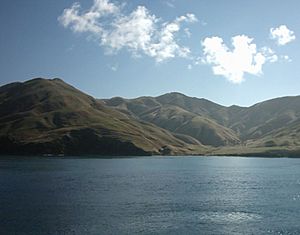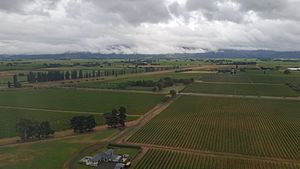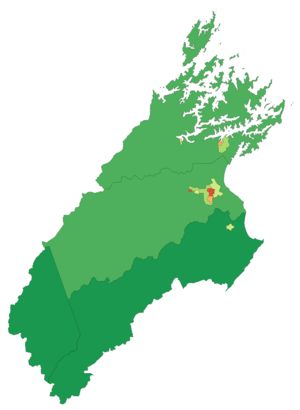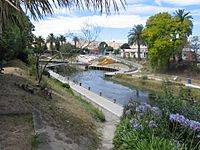Marlborough District facts for kids
Quick facts for kids
Marlborough
Te Tauihu-o-te-waka
|
|
|---|---|
|
Territorial authority
Region |
|

The Marlborough Sounds seen from the Wellington–Picton ferry
|
|

Location in New Zealand
|
|
| Country | New Zealand |
| District | 1989 |
| Unitary authority | 1992 |
| Seat | Blenheim |
| Wards | Blenheim Marlborough Sounds Wairau-Awatere |
| Area | |
| • Total | 12,484.59 km2 (4,820.33 sq mi) |
| • Land | 10,457.79 km2 (4,037.78 sq mi) |
| Population
(June 2023)
|
|
| • Total | 52,200 |
| • Density | 4.181/km2 (10.829/sq mi) |
| Time zone | UTC+12:00 (NZST) |
| • Summer (DST) | UTC+13:00 (NZDT) |
| Postcode(s) |
Map of postcodes
|
| Area code | 03 |
| ISO 3166 code | NZ-MBH |
| HDI (2017) | 0.919 very high · 6th |
| Website | Marlborough.govt.nz |
Marlborough is a special place in New Zealand. It's a region and a district all in one! You can find it on the northeast side of the South Island. Its Māori name is Te Tauihu-o-te-waka, or just Tauihu.
Marlborough is famous for a few things. It has a very dry climate, beautiful Marlborough Sounds, and delicious Sauvignon blanc wine. The main town and where the local government is located is Blenheim. Marlborough was named after a famous English general, the 1st Duke of Marlborough.
Contents
Exploring Marlborough's Geography
Marlborough's land can be split into four main parts. The south and west areas are very mountainous. These mountains are the northern end of the Southern Alps. The Kaikōura Ranges are found here.
Rivers and Plains
In the middle of Marlborough, you'll find the long, straight valley of the Wairau River. This valley opens up into wide, flat plains as it reaches the east. The town of Blenheim sits right in the middle of these plains. The soil here is very rich, and the weather is mild. This makes it a perfect spot for growing grapes for the New Zealand wine industry.
The Marlborough Sounds
Along the north coast, you'll discover the amazing Marlborough Sounds. These are like drowned valleys, creating a coastline with many twists and turns. It's a very beautiful area. The town of Picton is at the end of one of the biggest sounds, called Queen Charlotte Sound. Another town, Havelock, is at the end of the Pelorus Sound. This sound connects to the Kenepuru Sound.
Marlborough's Climate
Marlborough has a mild oceanic climate. This means it has warm summers and cool winters. Rain falls throughout the year. It's known for its sunny days, which helps the grapes grow well!
People of Marlborough
Marlborough Region covers about 10,458 square kilometers. It has an estimated population of 52,200 people. This means there are about 5.0 people living in each square kilometer.
In 2018, the population of Marlborough was 47,340. This was an increase of about 9% since 2013. The average age of people in Marlborough was 45.5 years old. About 17.4% of the people were under 15 years old.
Main Towns and Settlements
Marlborough has three main towns with more than 1,000 people. These towns are home to most of the region's population.
| Urban area | Population
(June 2023) |
% of region |
|---|---|---|
| Blenheim | 30,500 | 58.4% |
| Picton | 4,880 | 9.3% |
| Renwick | 2,630 | 5.0% |
Other smaller towns and places to live include:
- Anakiwa
- Grovetown
- Havelock
- Ngākuta Bay
- Ōkiwi Bay
- Rai Valley
- Rārangi
- Seddon
- Spring Creek
- Tuamarina
- Wairau Valley
- Ward
- Woodbourne
Different Cultures and Backgrounds
In 2018, most people in Marlborough (87.8%) were of European background. About 13.3% were Māori. There were also people from Pacific Islands (3.1%) and Asia (4.1%), plus other backgrounds. Many people in Marlborough were born in other countries, but most were born in New Zealand.
Marlborough's Economy
Marlborough's economy is strong. In 2019, its total economic output was about NZ$3.25 billion. This makes up about 1.1% of New Zealand's total economy.
Farming and Growing
Marlborough has a lot of land used for growing crops, about 25,045 hectares. This is the second-largest area in New Zealand for horticulture. Most of this land, about 23,050 hectares, is used for growing grapes for wine. Other crops like sweetcorn and peas are also grown.
The Famous Wine Industry

The climate in Marlborough is perfect for growing wine grapes. It has hot, sunny days and cool nights. This helps the grapes ripen slowly and develop strong flavours. The first vineyards were planted near Blenheim in 1973. Since then, Marlborough has become New Zealand's biggest and most famous wine region.
Marlborough now produces three-quarters of all New Zealand wine. The most important type of wine is Sauvignon Blanc. Many wine experts say Marlborough's Sauvignon Blanc is the best in the world! Sparkling wines, made from Chardonnay and Pinot Noir grapes, are also very important. Big French Champagne companies have even invested here.
Getting Around Marlborough
Marlborough has good transport links. Four main highways serve the region.
Roads and Highways
- State Highway 1 is the main road. It connects Picton and Blenheim. It also links Marlborough south to Christchurch.
- State Highway 6 connects Blenheim to Nelson and Tasman.
- State Highway 63 offers a direct route to the West Coast.
- State Highway 62 is a shorter road that connects Picton to Nelson, bypassing Blenheim.
Trains and Ferries
The Main North Line railway runs through Marlborough. The first part of this railway opened in 1875. Today, the Coastal Pacific passenger train uses this line during summer. Freight trains also use it a lot to carry goods between Christchurch and the Cook Strait ferry at Picton.
Port Marlborough in Picton is the main seaport. Ferries like Interislander and Bluebridge travel between Picton and Wellington.
Air Travel
Woodbourne Airport (also called Marlborough Airport) is the region's main airport. You can fly from Woodbourne to Auckland and Wellington. There are also flights from Picton Aerodrome to Wellington.
Learning in Marlborough
Marlborough has 29 schools for kids of all ages.
- There are 22 state primary schools.
- One state intermediate school, Bohally Intermediate, is in Blenheim.
- Three state secondary schools: Marlborough Boys' College and Marlborough Girls' College in Blenheim, and Queen Charlotte College in Picton.
- One state area school, Rai Valley Area School.
- There are also two special schools that combine state and private funding.
See also
 In Spanish: Región de Marlborough para niños
In Spanish: Región de Marlborough para niños




